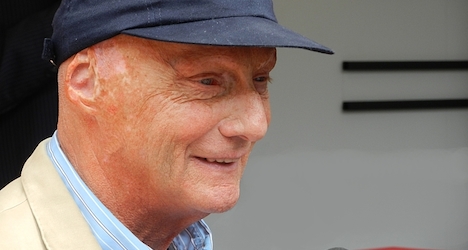SPORT
Expats keen but cricket still puzzles Austrians
The gentleman's game of cricket, re-introduced to Austria 40 years ago, is experiencing something of a renaissance. The Local Austria looks into the action, while wondering how to translate 'googly' into German.
Published: 16 June 2014 10:23 CEST

Niki Lauda is a keen cricketer. Photo: Wikimedia
Niki Lauda seemed irritated last year to have been asked by a journalist whether he was an Australian cricket fan – retorting that he was Austrian.
However, he had played in the traditional drivers' cricket matches played around the British Grand Prix weekend in the 1970s, so possibly the question was not so absurd as it might have seemed.
A few metres from the Ernst-Happel-Stadion in Vienna’s 2nd district is the home of Vienna Cricket & Football Club – ironically nowadays the club plays neither sport, focussing on tennis and athletics instead.
However, after its founding in the late 19th century, cricket flourished briefly until the outbreak of World War One, being a game popular with English gardeners, tradesmen and the expat staff of banks working in Vienna at that time.
Following a brief renaissance after World War Two, the sport was played by occupying British troops. The game then disappeared until 1975, when Kerry Tattersall, an Australian teaching English at the Handelsakademie V in Floridsdorf, introduced the game to his pupils as a way to try to increase their interest in learning English.
From the early intake of Austrian players who played in Tattersall’s XI – becoming Vienna Cricket Club, which turns 40 in 2015 – two players, Wolfgang Tesar, and Walter Blaschke, are still deeply involved with the sport, the former as Secretary of the Austrian Cricket Association, and the latter as a youth coach for Austria CC Wien.
Cricket has never enjoyed mainstream status in Austria – partially since as a non-Olympic discipline it struggles for acceptance by the local authorities in terms of funding. Similarly, with cricket and football seasons overlapping so much in Austria, many attempts to set up grounds have faltered.
Nevertheless there are three dedicated cricket grounds in Austria – in Markomannenstrasse in Vienna’s 22nd district, where there is a strong focus on youth cricket, at Vienna Cricket Club’s ground in Seebarn (NÖ), where the Austrian National Team also plays its home games, and also in Velden against the picturesque backdrop of the Karawanken, the home of CC Velden 91, a club run predominantly by native Carinthians.
Cyclists passing by Seebarn often stop to watch, fill their water bottles and cycle on, with many unsure as to which sport they have seen, with guesses varying from croquet to polo.
Cricket in Austria, as with cricket in much of mainland Europe, is predominantly played by expat populations (particularly the Pakistani, Indian, Sri Lankan, Bangladeshi and Afghani, British, Australian and South African populations), but the sport can now boast some indigenous talent as many of the youngsters, although originating from a cricketing nation, take up the game as children growing up in Austria, particularly through schools programmes.
Having hosted several international tournaments in the past, the Austrian National Team heads to Essex next week for Pepsi ICC Europe Division 2, where after playing at the County Ground in Chelmsford, further matches await against Belgium, Gibraltar, Isle of Man and Norway.
Url copied to clipboard!


 Please whitelist us to continue reading.
Please whitelist us to continue reading.
Member comments